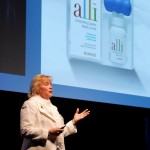GlaxoSmithKline’s Innovation: An Emotional Talisman
Point: Products that perform a rational purpose can fail if they don’t address emotional needs
Story: At the World Innovation Forum, Donna Sturgess, Global Head of Innovation at GlaxoSmithKline Consumer Healthcare, described some of the innovations behind Alli, an over-the-counter weight-loss drug which can help people lose 50% more weight. As I see it, the heart of the innovation lies beyond the physical chemistry of the medication (which blocks the absorption of fat) because the medication does no good if it’s not taken at mealtime. Instead, the real innovation is in the emotional chemistry of the small blue pill carrier called the Shuttle, which encourages the person to stay on their diet.
Alli faces two significant challenges. First, the pharmaceutical performance of a medication means nothing if patients don’t take the drug. Compliance could be a issue with Alli because it needs to be taken with meals, including meals eaten outside the home. That means people need to carry their pills with them.
Second, dieting comes with strong emotional issues. Dieters run a gauntlet of body self-image issues, willpower, fear of failure, and cravings as they attempt to achieve their goals. Sturgess cited data that emotional issues affect 85% of all decisions. Products that perform a rational purpose can fail if they don’t address emotional needs and wants.
To provide emotional support, GlaxoSmithKline designed the Shuttle to be both discrete and distinctive. The calming blue pill carrier looks like a contact lens case. The linear-arrangement of three smooth lobes fits comfortably in the hand. GlaxoSmithKline gave the Shuttle a smooth texture, like a worry-stone. The company intentionally left off any brand markings or names to avoid customer embarrassment — only fellow Alli users know what the little blue case means. The point is that the Shuttle is more than just a functional accessory: it’s a emotional talisman to support dieting.
Action
- Consider the emotional experiences, contexts, and meaning of the product and the product’s use.
- Create product artifacts or accessories that support those emotional experiences.
- Use non-functional product attributes (e.g., color, shape, and surface texture) to convey emotion.
Photo courtesy of Dov Friedmann – PhotographybyDov.com
1 Comment »Case study, How-to, Innovation, New Product Development, Strategy










